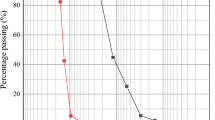Abstract
Properties of concrete are strongly dependent on its pore structure features, porosity being an important one among them. This study deals with developing an understanding of the pore structure-compressive strength relationship in concrete. Several concrete mixtures with different pore structures are proportioned and subjected to static compressive tests. The pore structure features such as porosity, pore size distribution are extracted using mercury intrusion porosimetry technique. A statistical model is developed to relate the compressive strength to relevant pore structure features.






Similar content being viewed by others
References
Bouguerra A, Amiri O, Ait-Mokhtar A and Diop M B 2002 Water sorptivity and pore structure of wood-cementitious composites. Mag. Concr. Res. 54 (2): 103–112
Diamond S 2004 The microstructure of cement paste and concrete – a visual primer. Cem. Concr. Compos. 26 (6): 919–933
Stark J 2011 Recent advances in the field of cement hydration and microstructure analysis. Cem. Concr. Res. 41 (5): 666– 678
Kearsley E P and Wainwright P J 2002 The effect of porosity on the strength of foamed concrete. Cem. Concr. Res. 32 (2): 233–239
Kumar R and Bhattacharjee B 2003 Porosity, pore size distribution and in situ strength of concrete. Cem. Concr. Res. 33 (1): 155–164
Marfisi E, Burgoyne C J, Amin M H G and Hall L D 2005 The use of MRI to observe the structure of concrete. Mag. Concr. Res. 57 (2): 101–109
Lian C, Zhuge Y and Beecham S 2011 The relationship between porosity and strength for porous concrete. Constr. Build. Mater. 25 (9): 4294–4298
Hasselman D P H and Fulrath R M 1966 Proposed fracture theory of a dispersion-strengthened glass matrix. J. Am. Ceram. Soc. 49 (2): 68–72
Wagh A S, Singh J P and Poeppel R B 1993 Dependence of ceramic fracture properties on porosity. J. Mater. Sci. 28 (11): 3589–3593
Liu D -M 1997 Influence of porosity and pore size on the compressive strength of porous hydroxyapatite ceramics. Ceram. Int. 23 (2): 135–139
Palchik V 1999 Influence of porosity and elastic modulus on uniaxial compressive strength in soft brittle porous sandstones. Rock Mech. Rock Eng. 32 (4): 303–309
Luping T 1986 A study of the quantitative relationship between strength and pore size distribution of the porous materials. Cem. Concr. Res. 16 (1): 87–96
Schiller K K 1971 Strength of porous materials. Cem. Concr. Res. 1 (4): 419–422
Chen X, Wu S and Zhou J 2013 Influence of porosity on compressive and tensile strength of cement mortar. Constr. Build. Mater. 40 (3): 869–874
Popovics S 1985 New formulas for the prediction of the effect of porosity on concrete strength. ACI J. Proc. 82 (2): 136– 146
Shi C 1996 Strength, pore structure and permeability of alkali-activated slag mortars. Cem. Concr. Res. 26 (10): 1789– 1799
O’Farrell M, Wild S and Sabir B B 2001 Pore size distribution and compressive strength of waste clay brick mortar. Cem. Concr. Res. 23 (1): 81–91
Wen C E, Yamada Y, Shimojima K, Chino Y, Hosokawa H and Mabuchi M 2004 Compressibility of porous magnesium foam: Dependency on porosity and pore size. Mater. Lett. 58 (3–4): 357–360
Pecqueux F, Tancret F, Payraudeau N and Bouler J M 2010 Influence of microporosity and macroporosity on the mechanical properties of biphasic calcium phosphate bioceramics: Modeling and experiment. J. Eur. Ceram. Soc. 30 (4): 819– 829
Tang L 1986 A study of the quantitative relationship between strength and pore-size distribution of porous materials. Cem. Concr. Res. 16 (1): 87–96
Ryshkewitch E 1953 Compression strength of porous sintered alumina and zirconia. J. Am. Ceram. Soc. 36 (2): 65–68
Laskar M A I, Kumar R and Bhattacharjee B 1997 Some aspects of evaluation of concrete through mercury intrusion porosimetry. Cem. Concr. Res. 27 (1): 93–105
Shi D, Brown P W and Ma W 1991 Lognormal simulation of pore size distribution in cementitious materials. J. Am. Ceram. Soc. 74 (6): 1861–1867
Deo O and Neithalath N 2011 Compressive response of previous concretes proportioned for desired porosities. Constr. Build. Mater. 25 (9): 4181–4189
Todinov M T 2009 Is Weibull distribution the correct model for predicting probability of failure initiated by non-interacting flaws? Int. J. Solids Struct. 46 (3–4): 887–901
Savolainen P T, Mannering F L, Lord D and Quddus M A 2011 The statistical analysis of highway crash-injury severities: A review and assessment of methodological alternatives. Accid. Anal. Prev. 43 (3): 1666–1676
Poon C S, Kou S C and Lam L 2006 Compressive strength, chloride diffusivity and pore structure of high performance metakaolin and silica fume concrete. Constr. Build. Mater. 20 (8): 858–865
Acknowledgements
Financial support for this research was provided by the National Natural Science Foundation of China (Grant Nos. 51279054 and 51279052).
Author information
Authors and Affiliations
Corresponding author
Rights and permissions
About this article
Cite this article
BU, J., TIAN, Z. Relationship between pore structure and compressive strength of concrete: Experiments and statistical modeling. Sādhanā 41, 337–344 (2016). https://doi.org/10.1007/s12046-016-0468-9
Received:
Revised:
Accepted:
Published:
Issue Date:
DOI: https://doi.org/10.1007/s12046-016-0468-9




